17 Types of Lawn Mushrooms (with Pictures) – Identification Guide
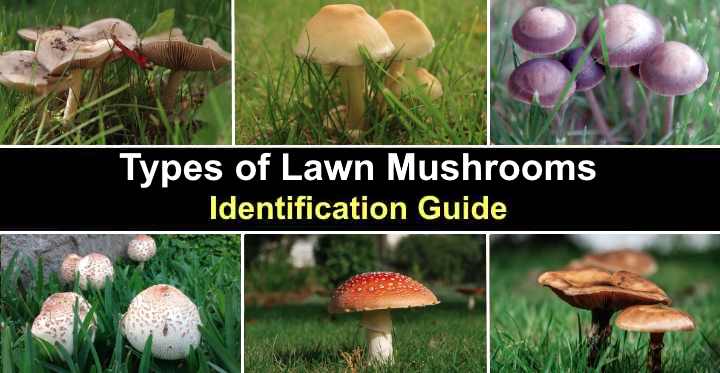
Mushrooms growing in lawns are a common sight. Small clusters of white, brown, orange or even red fungi can appear in grass seemingly from nowhere. Most types of lawn mushrooms have a characteristic umbrella-shaped or flat cap on top of a slender stem. Even though many mushroom species prefer shaded areas, lawn mushrooms have the habit of popping up even in sunny yards.
Many varieties of common garden mushrooms are white with domed caps, have brown or white gills, and grow in small groups among grass blades. For example, false parasol mushrooms (Chlorophyllum molybdites), field mushrooms (Agaricus campestris), puffball mushrooms, and white dunce caps (Conocybe apala) are all types of common garden mushrooms.
However, several varieties of mushrooms that grow on lawns are orange, tan, or brown. For example, fairy ring mushrooms, weeping widow mushrooms (Lacrymaria velutina), Agaricus placomyces, and scruffy twiglets (Tubaria furfuracea) are colorful lawn mushrooms.
Correctly identifying species of mushrooms in your yard is vital. This article is only a rough guide to help recognize common garden mushrooms. It is not meant to be a definitive guide for identifying poisonous lawn mushrooms or give advice on picking mushrooms in your garden.
Some types of mushrooms in gardens are highly poisonous and can cause severe health consequences. Therefore, never eat any type of mushroom from your garden without identifying the species with 100 percent certainty.
In this article, you will find helpful tips and guidelines about lawn mushroom identification. In addition to descriptions, pictures of common garden mushrooms will help you spot the type of fungi growing in your lawn.
How to Identify Lawn Mushrooms
The identifying features of common lawn mushrooms are the color, cap shape, length of the stem, the color of gills under the cap, and aroma. Some mushrooms in the yard have a spongy feel, whereas others have gills or pores under the cap. Slicing the mushroom also reveals the color of the flesh.
Why Mushrooms Grow in Lawns
Mushrooms growing in your lawn are a sign your lawn and soil have plenty of organic matter. Lawn mushrooms are fruiting bodies that feed on decaying organic material. Fungi grow in lawns when conditions are ideal. This is when there is usually plenty of rainfall, high humidity, warm weather, and shaded conditions.
Some varieties of lawn mushrooms appear in late summer or early fall in your yard after it’s been raining. These white spongy growths contrast with lush green grass, making them easy to spot. The appearance of yard mushrooms is a sign they are decomposing organic matter in the soil, boosting the nutrient content of your turfgrass.
Mushrooms also grow in lawns if there are old tree stumps under the surface. For example, you may see fairy ring mushrooms growing in a circle in the middle of a lawn. These orange-brown mushrooms grow from decaying wood below the surface.
What should you do about mushrooms growing in your lawn? In most cases, you can leave them or run the lawn mower over them. However, if you are concerned about poisonous lawn mushrooms, you could remove them and put them in the compost heap.
Types of Lawn Mushrooms (With Pictures) – Identification Guide
Let us take a closer look at the various kinds of yard mushrooms that appear in lawns.
Fairy Ring Lawn Mushroom (Marasmius oreades)
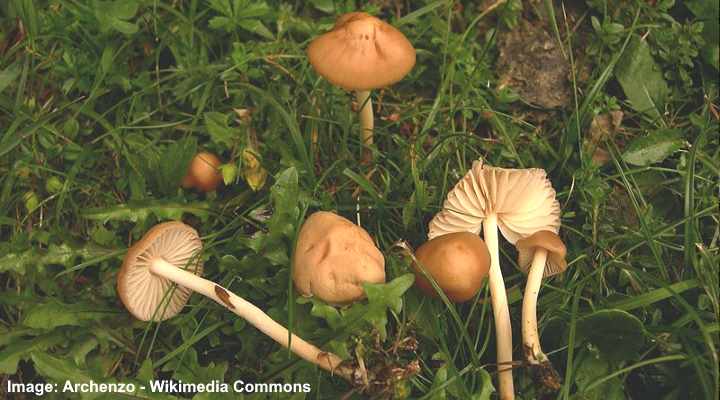
The fairy ring lawn mushrooms grow in clusters, have long skinny stems, brown or tan caps and feed on decaying wood in the garden
The fairy ring mushroom is identified by its round pale tan or brownish-orange flat or bell-shaped cap, long cylindrical stem, and widely spaced gills. A distinctive habit about fairy ring mushrooms is how they often grow in a circle in grassy areas. This edible lawn mushroom feeds on decaying wood matter in lawns.
Fairy ring lawn mushrooms grow 1” to 2.5” (2 – 6 cm) tall with caps 0.5” to 5” (1 – 5 cm) in diameter. This common yard mushroom often grows in lawns and meadows from summer through fall.
Lawn Mushroom Identification
Fairy ring lawn mushrooms have an identifiable tan to brown cap with a noticeable bump in the center. These lawn mushrooms grow in groups, forming arcs or rings.
False Parasol (Chlorophyllum molybdites)
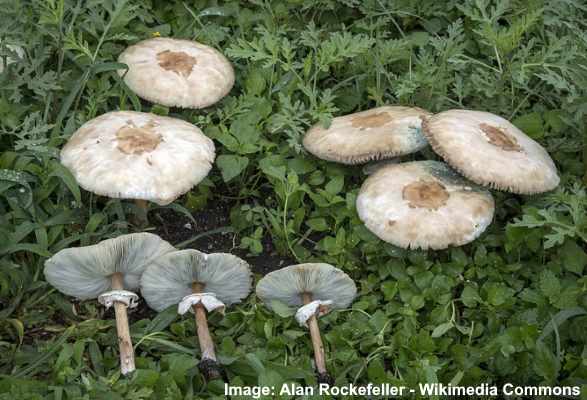
The false parasol is a lawn mushroom with a white flat cap and a brown circle in the middle and a slender stem
The false parasol is a white lawn mushroom with a large spherical cap that flattens as it grows. As the white mushroom matures, it develops a scaly cap with a pinkish-brown to brown center. This lawn mushroom grows in fairy rings in lawns throughout North America.
The false parasol mushroom grows 3.14” to 7.8” (8 – 20 cm) tall, and its large whitish-brown cap can grow 4” to 8.6” (10 -22 cm) wide. It has white flesh and densely-growing white gills that gradually turn grayish-green.
Lawn Mushroom Identification
The false parasol is identified by its large, round, relatively flat cap sitting on top of straight, erect white to brown stems.
Field Mushroom (Agaricus campestris)

Field Mushrooms can be identified by their white cap and brownish gills and are commonly found in grassy areas
The field mushroom is a white edible mushroom that commonly grows in lawns. Also called the meadow mushroom, this fungus is identified by its broadly convex white cap, dark pink or brown gills, and a thick white ringed stem. Although edible, the field mushroom has poisonous look-alike mushrooms.
The field mushroom has a thick stem 1.18” to 4” (3 – 10 cm) tall and 0.78” (2 cm) wide. Its round white, almost flat cap grows 1.18” to 4.7” (3 – 12 cm) wide. Other features of this lawn mushroom are its white, non-staining flesh and gills that start pink and then turn dark brown.
Lawn Mushroom Identification
The common field mushroom is identified by its white color, stocky growth, and habit of growing in grassy areas.
White Dunce Cap (Conocybe apala)
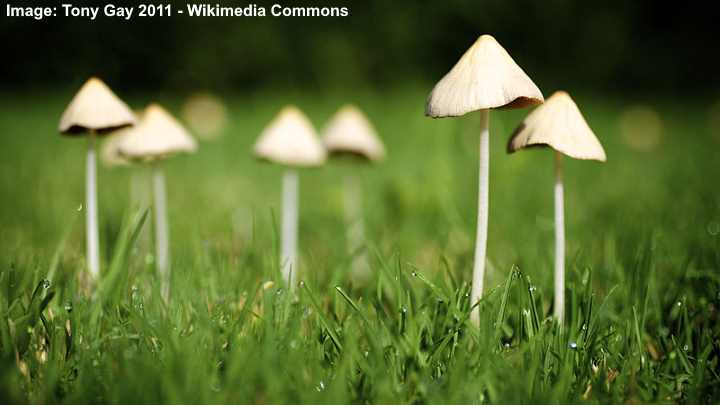
White dunce cap mushrooms have a very thin stem with a creamy white conical cap and can be found in grassy yards and lawns
The white dunce cap is a slender, small white mushroom with a distinctly pointed pyramidal cap and rusty-brown gills. The conical white cap gradually opens to a parasol shape as the tiny mushroom grows. These small white mushrooms are hard to spot among grass due to their size.
The white dunce cap grows 2.7” to 4” (7 – 10 cm) long, and its pointed bell cap is 0.6” to 1.18” (1.5 – 3 cm). The pale-cream-colored mushroom commonly grows in pastures, lawns, meadows, and other grassy areas with short grass. It appears in lawns on warm sunny mornings but may disappear by the afternoon.
Lawn Mushroom Identification
The white dunce cap mushroom is easily identifiable due to its ultra-thin stem and conical white cap on the end.
Weeping Widow Mushroom (Lacrymaria velutina)
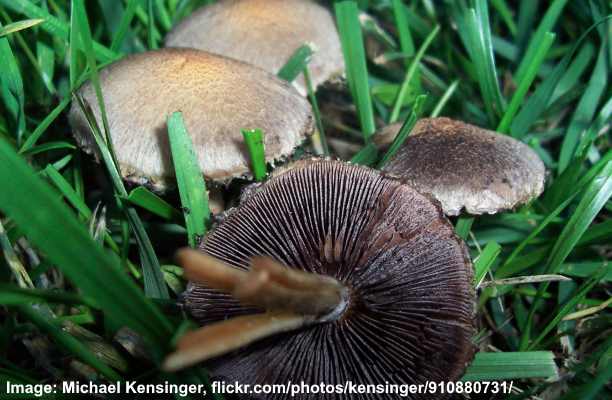
The weeping widow lawn mushroom can have a flat or bell-shaped pale brown cap and dark brown gills
The weeping widow fungus is a large, pale brown mushroom with a broadly bell-shaped or flattened cap, dark brown gills, and a whitish-tan stem. This common yard mushroom can grow solitary in lawns or in large clusters. You will find this brown lawn mushroom in pastures, lawns, or fruiting from dead hardwood trees.
The impressive weeping widow mushroom has a long 1.5” to 4” (4 – 10 cm) stem and a cap measuring 1.18” to 3.1” (3 – 8 cm) wide. Sometimes its stem can be as thick as it is long.
Lawn Mushroom Identification
The identifying features of the weeping widow mushroom are its large tan-colored bell-shaped cap, robust stem, and dark brown gills. It also has white or brownish flesh.
Candolleomyces candolleanus
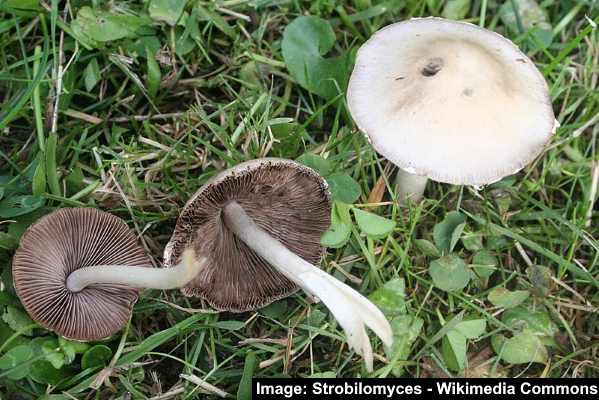
The candolleomyces candolleanus mushroom is characterized by skinny white stem and rounded white cap with brown gills
The Candolleomyces candolleanus is a white mushroom with a large parasol-like cap, white stalk, and dark brown contrasting gills. A characteristic of this white lawn mushroom is its round white cap with radially asymmetrical and irregular edges. The common mushroom can be found on lawns, pastures and growing around tree stumps.
The Candolleomyces candolleanus grows 1.5” – 4” (4 – 10 cm) tall, and its cap grows up to 3” (7.5 cm) wide.
Lawn Mushroom Identification
The Candolleomyces candolleanus is a common lawn mushroom, identified by its round flat white cap with a bump in the center, dark brown gills, and a slender white stem.
Agrocybe pediades
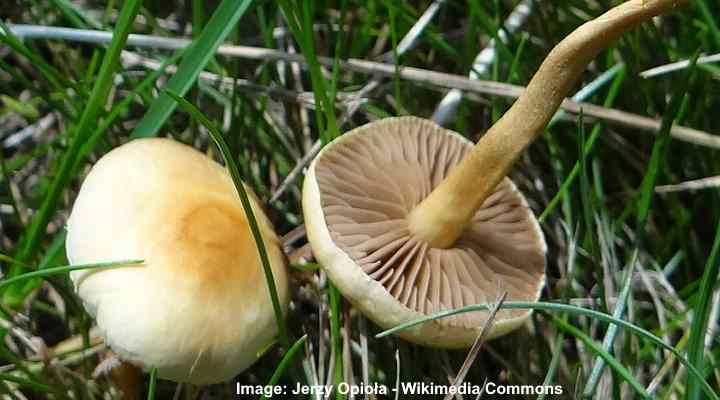
The agrocybe pediades is a common lawn mushroom with a creamy white flat cap and a slim stem
The Agrocybe pediades is a typical lawn mushroom with a conical whitish-tan cap, slender brown stem, and darker brown gills. A feature of this small mushroom is its sticky cap. Additionally, the creamy white cap becomes flattened as the mushroom matures. Although it’s an edible yard mushroom, it has toxic look-alikes.
The slender light brown Agrocybe pediades stalks grow 0.78” to 2” (2 – 5 cm) tall, and its pointed cap is 0.39” to 1.18” (1 – 3 cm) wide at the base. This mushroom grows in grassy areas, lawns, meadows, and on compost heaps.
Lawn Mushroom Identification
The identifying features of the Agrocybe pediades are its creamy white to tan color, smooth, tacky conical cap, and slender straight stem.
Agaricus placomyces
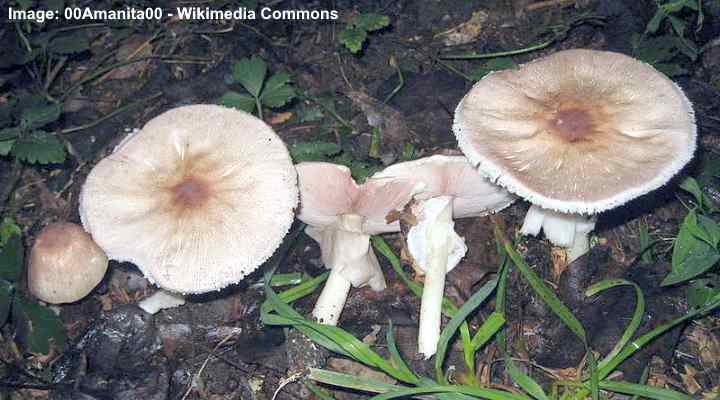
The agaricus placomyces mushroom grows in lawns under trees and has a pale flat cap with a darker center
The Agaricus placomyces mushroom is identified as a large whitish-tan to pale-brown fruiting body with a flat cap, white scales, and smooth white stem. Features of this common lawn mushroom are its brownish scales and fibers on the thick cap, ragged margins, white flesh, and tall growth.
The Agaricus placomyces mushroom grows 2.3” to 6” (6 – 15 cm) tall, and its large, round, and often frayed brownish cap grows up to 6” (15 cm) wide. The large tan mushroom grows in lawns under trees through summer and fall.
Lawn Mushroom Identification
The Agaricus placomyces mushroom is identified by its broadly convex round light brown cap with a dark brown center and slightly upward growth at the margins.
Parasol Mushroom (Macrolepiota procera)
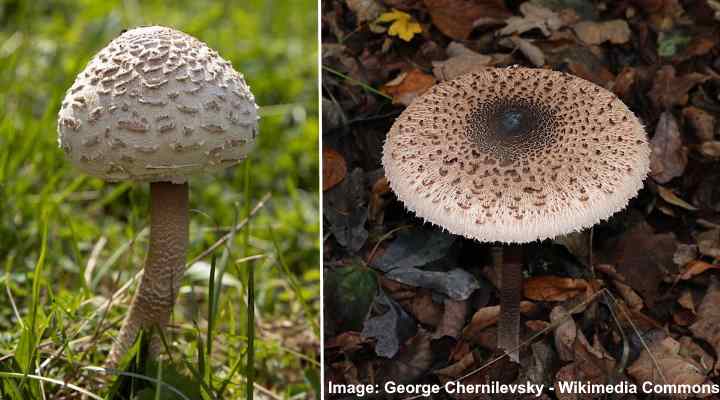
The parasol mushroom can be identified by its bell-shaped white scaly cap (left) which turns flat and brown as it matures (right)
The parasol mushroom is a white lawn mushroom with a distinctive rounded, bell-shaped cap covered in scaly growths. This large white mushroom emerges with a white, egg-shaped cap before gradually becoming bell-shaped, then flattened and chocolate brown. The underside of the scaly white cap has white, sometimes pink-tinged gills.
The parasol mushroom grows 12” to 15” (30 to 40 cm) tall with a large chocolate-brown cap. This edible lawn mushroom is prized for its size, taste, and versatility in the kitchen.
Lawn Mushroom Identification
The identifiable features of the parasol mushroom are its dome-like white cap covered with brownish scales on a tall stem.
Scruffy Twiglet Mushroom (Tubaria furfuracea)
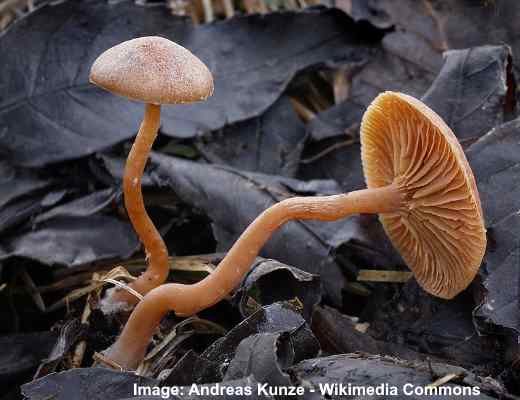
The small scruffy twiglet mushroom is an orange-brown in color and has a slender stem
The scruffy twiglet mushroom is a small orange-brown fungus with a flat to convex cap, whitish patterns, a slender stalk, and tawny brown gills. This common lawn mushroom can sometimes grow in large clusters in shaded areas of lawns under hardwood trees.
The tawny-brown mushroom grows 0.39” to 2” (1 – 5 cm) tall, and its flattish cap is up to 1.57” (4 cm) wide.
Lawn Mushroom Identification
The orangish-brown scruffy twiglet mushroom has a small, slightly rounded cap and a mild odor.
Common Morel (Morchella esculenta)
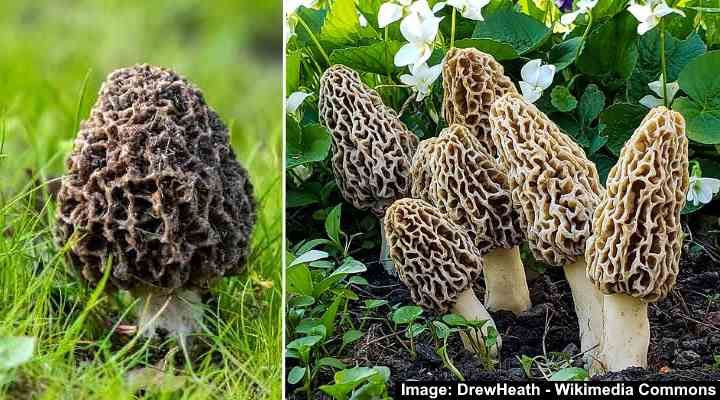
The common morel mushroom is identified by its unique patterned cap which can be pale or dark brown and relatively short stout stem
The common morel is a pale, brownish-cream to darker grayish-brown mushroom with a distinctive spongy appearance. The easily recognizable edible mushroom has an irregular, egg-shaped cap attached to a short, stout stem. This wild brown mushroom typically grows in lawns, pastures, and meadows.
The oval, bumpy sponge-like cap of the common morel measures 0.78” to 2.7” (2 – 7 cm) in diameter, and its stem is 0.78” to 3.5” (2 – 9 cm) long.
Lawn Mushroom Identification
The identifying feature of the common morel is its unique honeycomb-like appearance consisting of irregular ridges and holes.
Destroying Angel Mushroom (Amanita bisporigera)
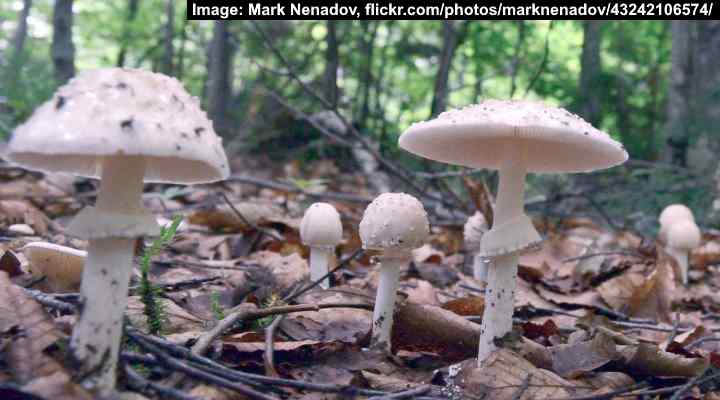
The poisonous destroying angel mushroom has a white rounded cap which flattens as it matures and a skirt-like ring around its stem
The destroying angel is a poisonous white lawn mushroom with a pure white cap, gills, flesh, and stem. The cap emerges somewhat egg-shaped before flattening out. The ivory color of this large mushroom may look attractive. However, this white mushroom can be deadly if consumed due to the level of toxins.
Destroying angel mushrooms grow 3” – 8” (7.5 – 20 cm) tall with a cap 2” – 4.5” (5 – 12 cm) wide. Foraging for mushrooms can be risky because the destroying angel is easy to mistake for edible meadow mushrooms, button mushrooms, or puffball mushrooms.
Lawn Mushroom Identification
The destroying angel mushroom is a poisonous white mushroom with an egg-shaped umbrella-like or flattened cap and a warning veil-like ring around its stem.
Shaggy Ink Cap (Coprinus comatus)
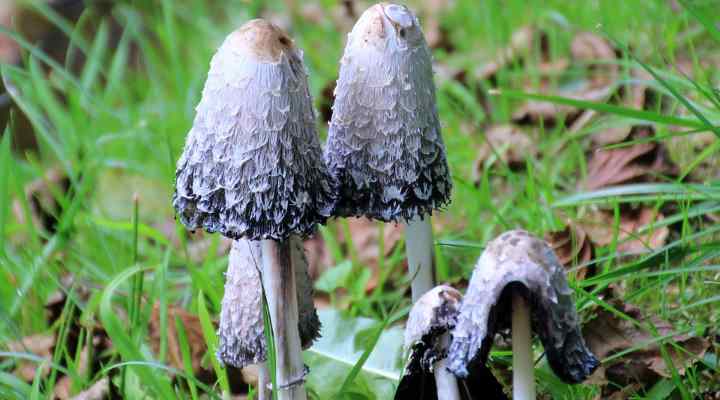
The shaggy ink cap mushroom grows in clusters in lawns and has a whitish conical cap with scaly black edges as it matures
The shaggy ink cap is a whitish mushroom with a conical or bell-shaped shaggy cap that can appear unexpectedly in lawns. The distinctive feature of this lawn mushroom is the black ink-like coloration on older specimens. The whitish-black mushroom grows in lines, clusters, or fairy rings on lawns.
The shaggy ink cap mushroom stem grows 2” to 8” (5 – 20 cm) tall, and the conical scaly cap can reach another 6” (15 cm) tall.
Lawn Mushroom Identification
The easily identifiable feature of the shaggy ink cap is its white conical cap that turns black and scaly as it matures.
Puffball Mushrooms in the Lawn
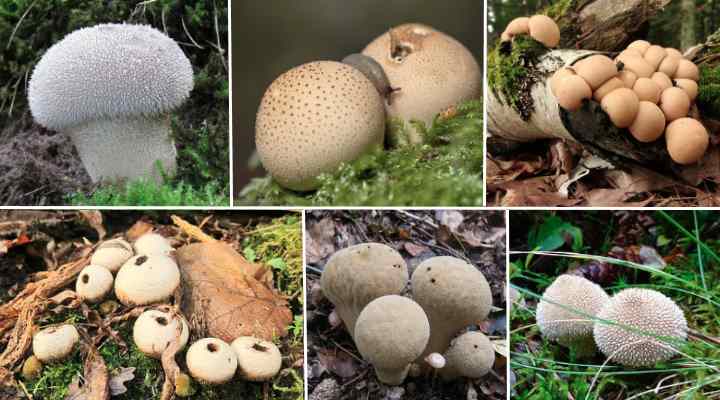
Puffball Mushrooms include many types of fungus ranging in size, color and texture, with some not having a visible stem
Puffball mushrooms are common white lawn mushrooms with ball-shaped fruiting bodies. Unlike most mushrooms growing in the yard, puffballs don’t have an open cap and some don’t have visible stalks. Instead, the white or pale brown fungal growths look like clusters of small eggs or white balls in lawns.
Puffballs mushrooms describe a wide variety of woodland and lawn mushrooms with an enclosed oval or round cap
Basket Stinkhorn Mushroom (Clathrus ruber)
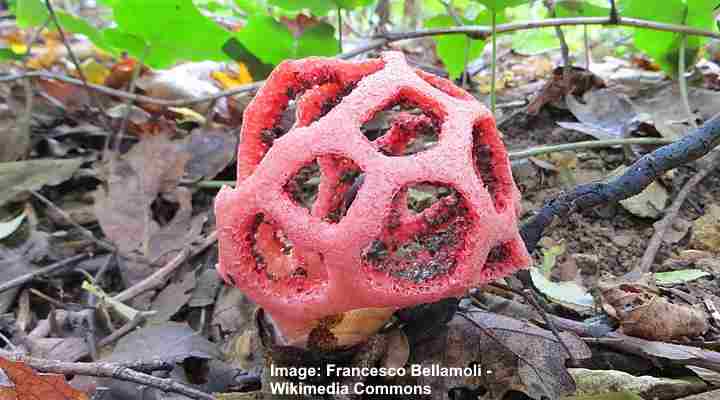
The unusual red basket stinkhorn mushroom can be found in lawns or yards and has a spherical latticed look
The basket stinkhorn mushroom is one of the most unusual lawn mushrooms due to its network-like growth of red spongy “arms.” The distinctive red mushroom looks like a ball-shaped pinkish-red basket covered with black spores in the center. This red lawn mushroom grows freely in yards and can measure up to 2.4” (6 cm) in diameter.
Lawn Mushroom Identification
The easily identifiable reddish basket stinkhorn consists of a mesh of arms, creating a lattice-like oval structure.
Pinwheel Mushroom (Marasmius rotula)
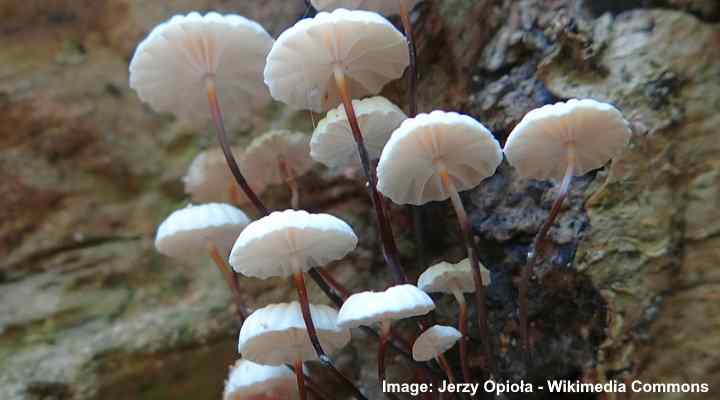
The delicate pinwheel mushroom has a thin dark stem with a small white cap with widely-spaced gills
The pinwheel mushroom is a dainty mushroom characterized by its thin white round cap on top of wiry brown stems. Depending on the growing conditions, the small mushroom can have brownish patches on white caps or dark brown caps. The widely-spaced gills are the same color as the cap.
The pinwheel mushroom grows 0.5” to 3.1” (1.2 – 8 cm) tall, and its tiny whitish cap can measure 0.1” to 0.8” (0.3 – 2 cm) in diameter.
Lawn Mushroom Identification
The pinwheel mushroom is a type of small fungi commonly found growing on lawns. Its characteristics are a thin brown stem supporting a convex-shaped whitish cap.
White Dapperling Lawn Mushroom (Leucoagaricus leucothites)
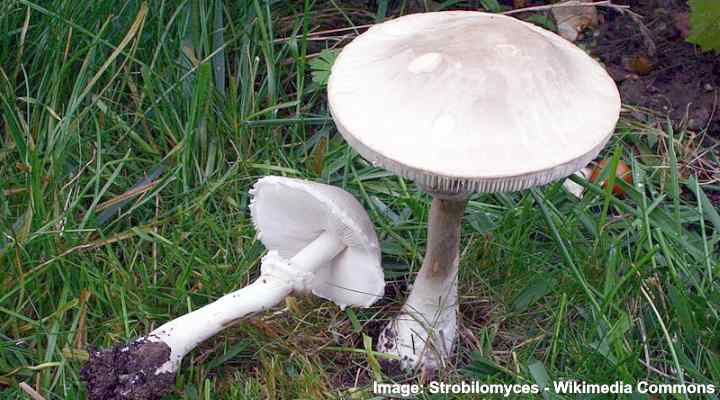
The white dapperling lawn mushroom has a rounded cap that becomes flat as it matures
Also called the white Agaricus mushroom, this large pure white mushroom commonly grows in lawns, parks, and grassy areas. The mushroom is identified by its egg-shaped cap that opens and eventually becomes flattened with a bump in the center. This mushroom is easily confused with the deadly death angel (Amanita ocreata).
The white dapperling mushroom grows 2” to 4.7” (5 to 12 cm) tall with a large rounded convex cap measuring 1.5” to 6” (4 – 15 cm) wide.
Lawn Mushroom Identification
The white dapperling mushroom is easy to identify due to its whitish cap, pure white gills, and white stem with a veil ring three-quarters up the stem. However, it’s good to note that this species has several poisonous look-alikes.
Learn How to Get Rid of Mushrooms in the Lawn.
Related articles:
